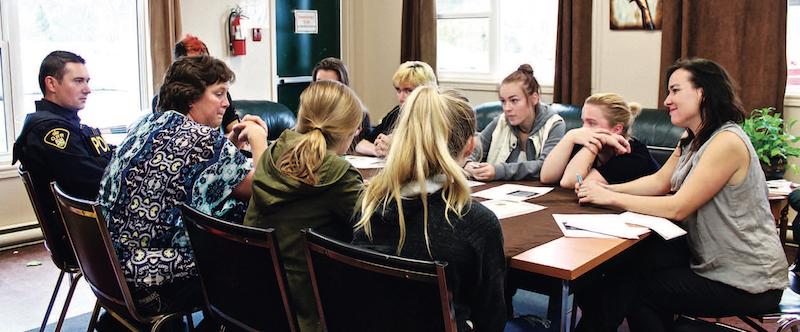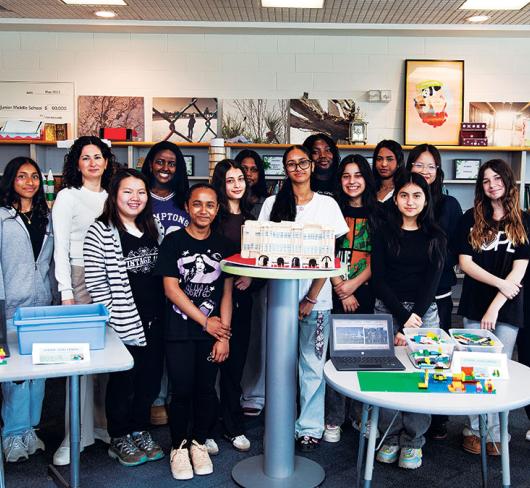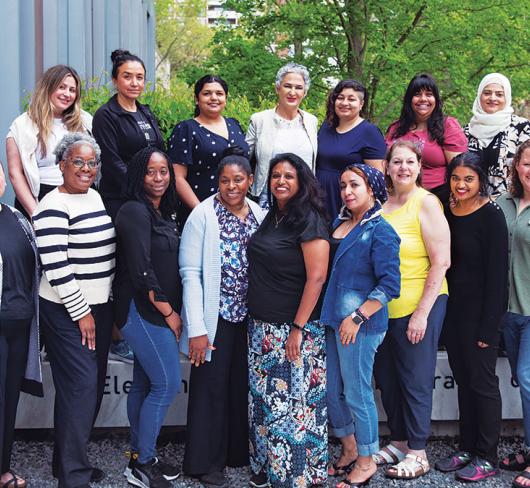
Making Space for Youth Leadership
Located two and a half hours equidistant between Toronto and Ottawa, Bancroft is a rural town where the first women’s shelter opened shortly after the mines closed in the 1980s. For a period of time Bancroft was a manufacturing hub, with an industry that contributed more than one million dollars a month in wages. This came to an end when a stagnating economy led to facilities closing up sites, which now sit abandoned.
Today, the average working wage in Bancroft is a barely livable $35,000 per year. In the heart of town, across from the LCBO, a food bank, North Hastings Community Cupboard, distributes 35,000 pounds of food every year. And while there are fewer than 4,000 people living in Bancroft there are four drug stores, within 200 yards of each other, all sites for distributing methadone.
Asking the Right Questions
Despite the fact that children live with the social and economic precarity endemic to our community, there have been few platforms where they can express their needs and feel heard, valued and represented.
In 2014, during a Grade 7/8 health class I asked my students to consider working with an elbow-partner to create mind-maps of healthy living choices. Using a gradual release of responsibility model, we brainstormed healthy development and personal responsibility.
The learning goal was for students to arrive at an understanding of how healthy active living is connected to the world and the community around us.
Interestingly, several students questioned the authenticity of the task. “No one actually listens to us anyways,” students said. “So why should we pretend to do this?”
It was a poignant question, which engaged other students in sidebar conversations about their own experiences. Their frustration came from a feeling that they confronted a number of consistent issues, had very good ideas to share, but felt that the community was choosing to ignore them.
Opening the Door for Change
During a conversation with the staff sergeant of the Bancroft OPP detachment, our school learned about Safer and Vital Communities funding. This funding is part of the Ministry of Community Safety and Correctional Services policy to support engagement programs and is allocated every two years.
Because this funding supports cross-ministry collaborations, it was a chance for the school to sit down and talk about ways students could be supported outside of class, on evenings, weekends and summer holidays.
Our school partnered with Bancroft’s Early Years Centre (North Hastings Children’s Services), which invited the OPP to sit down with them to discuss a grant that would fund adolescents studying rural issues and creating change. The idea of a youth advisory board emerged and 20 adolescents were invited to apply as leaders.
Adult leads were funded to advocate for the advisory board’s projects and to facilitate their success. “The advisory board was created to help promote health, reduce crime and create a lasting and tangible impact in our community,” said Sarah Phoenix-O’Neill, the project lead.
Less than six months after the proposal was written, the ministry allocated $70,000 to support the project. “We are thinking about growing up in a rural community and we are listening to a lot of people,” said Jade, a student advisor, who was in grade eight when she became a lead. “We are lending awareness to the issues facing teens today.” Using a two-tiered model, youth advisors began developing leadership skills while being paid for their research.
The Social Determinants of Health: A Survey for Youth by Youth
One of the first projects that youth undertook was to write a survey and administer it at local schools during their lunch breaks. Over 100 adolescents responded, sharing experiences of food insecurity, geographic isolation, social conflict, need for accessible spaces to hang out and mental health issues, among others.
Just getting to events presents an obstacle for adolescents; 25 per cent stated that they missed out on activities because they couldn’t get a ride. Fifty-three per cent of respondents said they needed a parent to drive them to activities, which can be an obstacle in homes with only one vehicle. In rural communities like Bancroft, public buses simply don’t exist. With not enough access to transportation but easy access to controlled substances and regular exposure to social conflict, many youth found themselves in a predicament that could be hard to break out of.
Food Security and Hunger
Youth advisors also demonstrated correlations between food insecurity and conflict with the law. Twenty-five per cent of youth experiencing food insecurity indicated that they have resorted to stealing as a result of being hungry.
In response to this data, youth advisors made healthy snacks more accessible in schools through snack programs and food delivery. “It was amazing to see the children’s faces when we delivered the snacks,” said youth advisor Jewelian, who now attends North Hastings High School. “We have been cooking and learning new recipes also,” said Kelsey during a community breakfast when youth advisors prepared a feast for toddlers and their parents over the holiday season and built nutrition into every outreach program.
Operation Youth and Creating Student-Friendly Spaces in the Community
The OPP decided to pilot Operation Youth, a positive ticketing program after youth advisors said that kids need more positive reinforcement. It involves police officers stopping and rewarding students who are seen as being leaders in the community.
Tickets are really vouchers that can be traded in for food at local stores, serving the double purpose of acknowledging positive behavior and offering free snacks.
Youth advisors also took it upon themselves to address the need of youth to have places where they can hang out in the community. “Teenagers need to believe that they fit into their communities,” said Zoey, a youth advisor. “When teenagers feel included they will work hard at what they believe in.” In the classroom, youth advisors asked their peers to identify “ally” businesses and spaces where they feel encouraged to just hang out.
Some of these spaces have since been transformed for the better. Near the skate park in downtown Bancroft, a colourful mural is one example. It involved youth advisors engaging more than 200 people to paint wooden puzzle pieces. Artists as young as six months and as old as 85 years participated in making the mural together, creating relationships in the process.
Staying in School and Mental Health
The work of the advisory board has also focused on mitigating the obstacles facing youth in completing school, one of which is confronting mental health issues that have their onset in adolescence. In Bancroft, youth advisors have begun talking openly about challenges that are pervasive for youth in this community.
Advising local town councillors about how mental health concerns play out for local youth has become a regular project for young people in North Hastings. And their insights have helped inform the town’s safety and well-being strategies.
“Finishing school is just hard to get my head around,” said Tyler. “It worries me that I still have four years to go.” What makes Tyler’s statement unique is that it was made to municipal council, which he attends as part of a youth delegation.
Coming Full Circle
One of the greatest insights I have gained by watching my students grow within the community is that adults need only to listen to hear what is needed and to open the door to the hard work that makes change for the better possible.
It was towards the end of the school year when I bumped into a youth advisor downtown. She was ecstatic because she had been invited to provide insights during a local television show, called Croft Talks, before a live audience of close to 200 people. Jade would provide her perspectives on rural living alongside veteran award-winning journalist Mark Bonokoski and retired OPP officer Jim Eadie.
“I was asked to share my feelings about growing up in Bancroft and the experiences of my peers,” she said excitedly. “People are genuinely interested and they want to hear from us.”
It has now been two years since that first lesson when I tried to initiate an active citizenship anchor chart in my intermediate health classroom, but instead inadvertently opened the door to what became a collaborative community transformation.
Classrooms can be gateways to the community, where multiple partners come together to create pathways for student success. As we have seen in Bancroft, connecting students and making their voices a valuable resource in the community benefits everyone and brings us all closer.
Sarah Vance is a member of the Hastings-Prince Edward Teacher Local.

